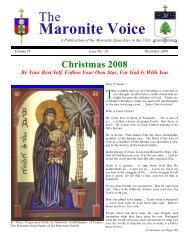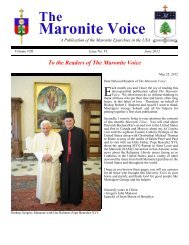Maronite Voice - Eparchy of Saint Maron of Brooklyn
Maronite Voice - Eparchy of Saint Maron of Brooklyn
Maronite Voice - Eparchy of Saint Maron of Brooklyn
You also want an ePaper? Increase the reach of your titles
YUMPU automatically turns print PDFs into web optimized ePapers that Google loves.
y Carla Haibi<br />
O<br />
n a corner <strong>of</strong> Henry and Remsen<br />
[Streets] in <strong>Brooklyn</strong> Heights, a<br />
majestic cathedral casts its<br />
shadow on the neighboring<br />
brownstones and streets lined with<br />
cherry blossom trees. Every day at<br />
11a.m., at Our Lady <strong>of</strong> Lebanon<br />
<strong><strong>Maron</strong>ite</strong> Cathedral, singing bells signal<br />
the beginning <strong>of</strong> Mass, a ritual where<br />
parishioners, the majority Lebanese<br />
immigrants, gather to pray, give thanks<br />
and ask for peace in Lebanon and the<br />
world. On a Sunday in mid-April, the<br />
church that seats 1200 is sparsely filled<br />
with 200 devoted parishioners who<br />
come to hear Mass celebrated in three<br />
languages, Arabic, English and Syriac.<br />
The creed and the readings are recited<br />
in English and then in Arabic and<br />
Syriac, a pattern followed through the<br />
hour-long mass. The choir also sings in<br />
multiple languages, accompanied by a<br />
great pipe organ.<br />
The three languages symbolize that<br />
the <strong><strong>Maron</strong>ite</strong> church strives to unite<br />
people, allowing them to become more<br />
tolerant and integrate them in the<br />
spiritual celebration regardless <strong>of</strong> their<br />
background, explained the Rev. James<br />
<strong>Brooklyn</strong>, New York<br />
Keeping the Tradition Alive<br />
Lebanese <strong><strong>Maron</strong>ite</strong>s at the weekly c<strong>of</strong>fee hour. (Photo by Carla Haibi).<br />
Root, Pastor <strong>of</strong> the Cathedral for two<br />
years. “I personally don’t believe in all-<br />
Arabic Mass or all-English Mass,” he<br />
said. “This way we include everyone,<br />
those who understand Arabic and those<br />
who don’t.”<br />
Root is actually Lebanese-German.<br />
His maternal grandparents immigrated<br />
to the United States from Lebanon in<br />
1912, escaping the rigid Ottoman rule,<br />
and have never returned. The one thing<br />
that kept them connected with their<br />
heritage is their love for their<br />
community and their church, explained<br />
Root. From then on, the traditions were<br />
transferred to the following generations.<br />
“It was important for us to keep our<br />
<strong><strong>Maron</strong>ite</strong> church alive, and through it,<br />
we kept alive many <strong>of</strong> the Lebanese<br />
customs as well, language, food and<br />
folklore. All <strong>of</strong> [these] things are<br />
important aspects <strong>of</strong> who we are, as<br />
Lebanese and as <strong><strong>Maron</strong>ite</strong>,” he said.<br />
As a way to maintain the Lebanese<br />
traditions, the Cathedral organizes<br />
Arabic language studies; a weekly<br />
c<strong>of</strong>fee hour and an occasional Lebanese<br />
breakfast after Mass, in addition to an<br />
annual Lebanese Food Fair. “We have<br />
to have everything, a blend. You can’t<br />
forget the past, that would be one <strong>of</strong> the<br />
biggest atrocities to life, to ignore who<br />
you are, why you are and where you<br />
have come from. We cannot do it,” said<br />
Root emphatically.<br />
Our Lady <strong>of</strong> Lebanon Cathedral is<br />
the only <strong><strong>Maron</strong>ite</strong> Church in New York<br />
City and the first neo-Romanesque<br />
church in the United States. The church<br />
was built in 1847 for<br />
Congregationalists. In 1944, the<br />
<strong><strong>Maron</strong>ite</strong>s bought it. Prior to that, <strong>Saint</strong><br />
Joseph <strong><strong>Maron</strong>ite</strong> Church in Lower<br />
Manhattan and our Lady <strong>of</strong> Lebanon on<br />
Hicks street in <strong>Brooklyn</strong>, a block from<br />
where the church is today, were the<br />
shrines for <strong><strong>Maron</strong>ite</strong>s in the city.<br />
The Church was remodeled into an<br />
ornate cathedral with large stained glass<br />
windows that depict, with striking<br />
colors, the life <strong>of</strong> Christ and the Virgin<br />
Mary. A large mural <strong>of</strong> the Lady <strong>of</strong><br />
Lebanon on top <strong>of</strong> a hill overlooking a<br />
bay area in Lebanon stands above the<br />
altar. The altar is made <strong>of</strong> marble and<br />
onyx tiles bought from the French and<br />
Lebanese pavilions at the World Fair in<br />
Queens, when these were disassembled.<br />
Wooden arcades on both sides <strong>of</strong> the<br />
church give it an Eastern character.<br />
Roughly 75 thousand are registered<br />
<strong><strong>Maron</strong>ite</strong>s in the United States and <strong>of</strong><br />
these about 500 families in New York,<br />
the majority <strong>of</strong> which are Lebanese,<br />
according to the 2006 Official Catholic<br />
Directory. The <strong><strong>Maron</strong>ite</strong> Church is one<br />
<strong>of</strong> the largest Eastern-rite communities<br />
in the Catholic Church, according to the<br />
National Apostolate <strong>of</strong> <strong><strong>Maron</strong>ite</strong>s<br />
[NAM], an organization for the people<br />
<strong>of</strong> the <strong><strong>Maron</strong>ite</strong> Church supporting the<br />
work <strong>of</strong> priests.<br />
The <strong><strong>Maron</strong>ite</strong>s are followers <strong>of</strong><br />
<strong>Saint</strong> <strong>Maron</strong>, a Syrian hermit <strong>of</strong> the late<br />
fourth century. With a history plagued<br />
by persecutions, especially under the<br />
Ottoman rule, <strong><strong>Maron</strong>ite</strong>s scattered<br />
throughout the world, making the<br />
<strong><strong>Maron</strong>ite</strong> Church grow outside <strong>of</strong><br />
Lebanon and become international. In<br />
fact, the Church includes Canaanite<br />
Phoenician <strong><strong>Maron</strong>ite</strong>s, Aramean Syrian<br />
<strong><strong>Maron</strong>ite</strong>s, and Arab <strong><strong>Maron</strong>ite</strong>s, but<br />
also American, Brazilian, Australian,<br />
European, and African <strong><strong>Maron</strong>ite</strong>s.<br />
In 1920, the <strong><strong>Maron</strong>ite</strong>s <strong>of</strong> Lebanon<br />
became self-ruling under French<br />
Protection and by law the President <strong>of</strong><br />
the country has to be <strong><strong>Maron</strong>ite</strong>,<br />
The <strong><strong>Maron</strong>ite</strong> <strong>Voice</strong> Volume V Issue No. VII Page 4 July - August 2009

















